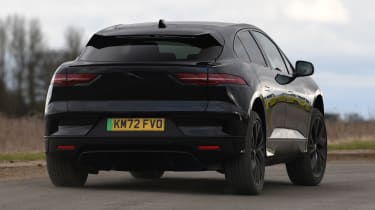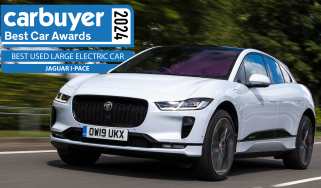Jaguar I-Pace review - Electric motor, drive & performance (2018-2024)
The way the I-Pace performs in corners sets a new benchmark for electric cars
Although the steering feels a little imprecise when the steering wheel is roughly straight, it quickly weights up in corners, giving you confidence to drive enthusiastically thanks to its precision. Combined with the lack of body roll, which is particularly impressive considering the I-Pace weighs over two tonnes, you have an SUV that feels incredibly nimble down a twisty road. This is mainly thanks to the car's weight being low down and well balanced for a low centre of gravity. However, if you're after a true sports car driving experience from your practical EV, you're better off looking at a Porcshe Taycan.
The only major weakness of the driving experience is the brakes – a recurring problem in electric cars that have brakes with a regenerative function; the brake pedal feels soft when you first press it and then firms up in an artificial way. Luckily, the regenerative braking of the electric motor means you don’t need to use the brakes much because the car starts to slow down as soon as you come off the accelerator, harvesting kinetic energy and putting it back into the battery pack. This is very intuitive, and once you get more used to braking in this way, it’s possible to drive the I-Pace with just one pedal most of the time.
More reviews
In-depth reviews
While the I-Pace looks sporty and low-slung, Jaguar has used its Land Rover know-how to ensure it's also surprisingly good off-road. Along with four-wheel drive, there’s All Surface Progress Control (ASPC), which is similar to cruise control for treacherous conditions. It makes it easy to keep going in muddy fields or up the steepest slopes anyone’s likely to tackle, relying on clever software to juggle power and traction between each wheel.
Jaguar I-Pace electric motors
The Jaguar I-Pace is powered by two electric motors, with one on each axle to provide four-wheel drive. Total combined power stands at 396bhp, with 0-62mph taking 4.8 seconds. In our testing it also leapt from 30 to 70mph in just 3.7 seconds, meaning there are few cars as quick when accelerating onto a fast road or overtaking. It’s worth noting that you get the same motor setup whichever I-Pace you opt for; there’s no performance benefit as you move up the range, even with the 400 Sport.
A top-spec Tesla Model X is faster than the I-Pace but the Jaguar is about much more than straight-line speed. The sense of accuracy and composure, along with the car’s surprisingly nimble feel means the I-Pace sets a new benchmark for the way electric cars drive.
The electric motors constantly shuffle power between the wheels to generate the most amount of grip possible in corners, meaning you almost feel the I-Pace maximising the traction on offer, without it ever seeming too unnatural. The suspension is similar in design to that in the Jaguar F-Type sports car, meaning the I-Pace stays flat and poised during quick changes of direction.










